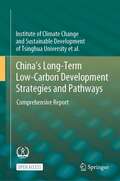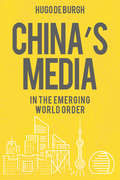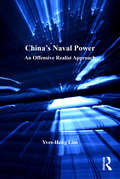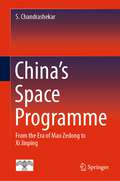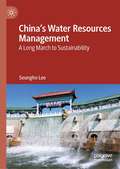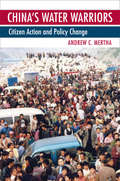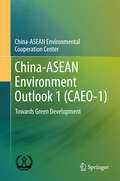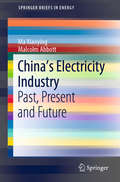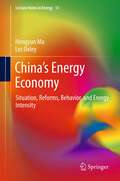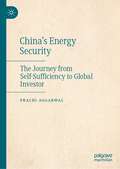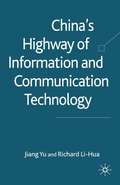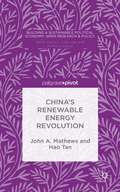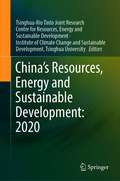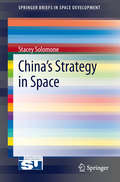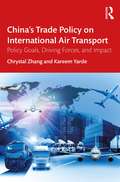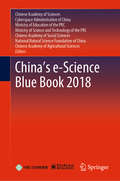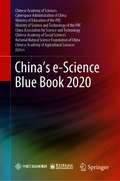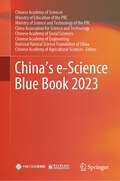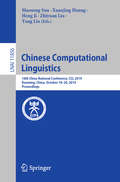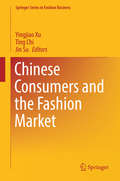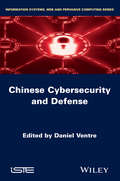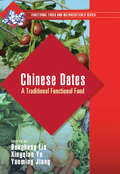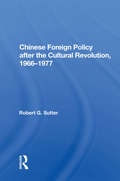- Table View
- List View
China's Long-Term Low-Carbon Development Strategies and Pathways: Comprehensive Report
by Institute of Climate Change and Sustainable Development of Tsinghua University et al.This open access book introduces a multi-disciplinary and comprehensive research on China's long-term low-carbon emission strategies and pathways. After comprehensively considering China’s own socioeconomic conditions, policy design, energy mix, and other macro-development trends and needs, the research team has proposed suggestions on China’s low-carbon development strategies and pathways until 2050, with required technologies and policies in order to realize the goals of building a great modern socialist country and a beautiful China. These achievements are in conjunction with the climate goals set in the Paris Agreement alongside Global Sustainable Development. The authors hope that the research findings can serve as a reference for all sectors of Chinese society in their climate research efforts, offer support for the formulation and implementation of china’s national low-carbon development strategies and policies, and help the world to better understand China’s story in the general trend of global green and low-carbon development.
China's Media in the Emerging World Order: how they came to be a powerful new force in media (Internationalizing Media Studies)
by Hugo De BurghChina is challenging the mighty behemoths, Google and Facebook, and creating alternative New Media. 750 million people are active on its Social Mediascape and there are a billion mobile phones deploying the innovative apps with which the Chinese conduct their lives.Though late starters, already four of the world's leading New Media companies are Chinese. China's old media - television, newspapers, radio - challenge the established powers which were long thought unassailable, such as CNN and BBC. Produced in many languages on every continent, they are re-defining the agenda and telling the story in China's way, with not just news and documentary series but also entertainment. The world's biggest manufacturer of TV drama is now making its stories for export.China's Media tells you why and how. It investigates the Chinese media, their strengths and weaknesses and how they are different. from the West. This detailed and comprehensive guide aims to showcase their immense variety and diversity, and demonstrates how they came to be a powerful new force in the media world.
China's Naval Power: An Offensive Realist Approach (Corbett Centre for Maritime Policy Studies Series)
by Yves-Heng LimThe rapid modernization of the Chinese Navy is a well-documented reality of the post-Cold War world. In two decades, the People's Liberation Army Navy has evolved from a backward force composed of obsolete platforms into a reasonably modern fleet whose growth is significantly shaking the naval balance in East Asia. The rationale behind China's contemporary rise at sea remains, however, difficult to grasp and few people have tried to see how the current structure of the international system has shaped Chinese choices. This book makes sense of Chinese priorities in its naval modernization in a 'robust' offensive realist framework. Drawing on Barry Posen's works on sources of military doctrine, it argues that the orientation of Beijing's choices concerning its naval forces can essentially be explained by China's position as a potential regional hegemon. Yves-Heng Lim highlights how a rising state develops naval power to fulfil its security objectives, a theoretical perspective that goes farther than the sole Chinese case.
China's Path to Innovation
by Xiaolan FuOver the past three decades, China has experienced rapid economic growth and a fascinating transformation of its industry. However, much of this success is the result of industrial imitation and China's continuing success now relies heavily on its ability to strengthen its indigenous innovation capability. In this book, Xiaolan Fu investigates how China can develop a strategy of compressed development to emerge as a leading innovative nation. The book draws on quantitative and qualitative research that includes cross-country, cross-province and cross-firm analysis. Large multi-level panel datasets, unique survey databases, and in-depth industry case studies are explored. Different theoretical approaches are also used to examine the motivations, obstacles and consequences of China's innovation with a wider discussion around what other countries can learn from China's experience. This book will appeal to scholars and policy-makers working in fields such as innovation policy, technology management, development and international economics and China studies.
China's Space Programme: From the Era of Mao Zedong to Xi Jinping
by S. ChandrashekarThis book comprehensively covers the history and current developments of space programme of China. It presents the complete story of China’s space programme from its origins through to present day activities on the International Space Station. This monograph further discusses the role of China’s space strategy in its emergence as a major power on the world stage. The book also presents the context of China’s space program within the larger narrative of international space development. The book binds together the diverse political, military, economic and technology aspects into a coherent understanding and explains their role in the establishment and growth of Chinese space programme. Given the contents, this book will be a valuable source of information for students, researchers, and historians in the area of space studies.
China's Water Resources Management: A Long March to Sustainability
by Seungho LeeThis book investigates water resources management and policy in China over the last two decades with a core focus on the role of water for socioeconomic development and sustainability. Recent policies, such as the Three Red Lines and the Water Ten Plan are evaluated for sustainable water supply, use and quality control. The book appraises solutions through demand management, water rights and pollution trading, virtual water and water footprint. Supply management is discussed taking examples from the Three Gorges Dam and the South North Water Transfer Project. The water market is investigated uncovering the active engagement of the private sector and includes discussions on how transboundary rivers demonstrate China’s engagement with its riparian countries for benefit sharing. This book will be an invaluable reference for researchers in the field as well as practitioners and students who have an interest in water and development in China.
China's Water Warriors: Citizen Action and Policy Change
by Andrew C. MerthaToday opponents of large-scale dam projects in China, rather than being greeted with indifference or repression, are part of the hydropower policymaking process itself. What accounts for this dramatic change in this critical policy area surrounding China's insatiable quest for energy? In China's Water Warriors, Andrew C. Mertha argues that as China has become increasingly market driven, decentralized, and politically heterogeneous, the control and management of water has transformed from an unquestioned economic imperative to a lightning rod of bureaucratic infighting, societal opposition, and open protest. Although bargaining has always been present in Chinese politics, more recently the media, nongovernmental organizations, and other activists--actors hitherto denied a seat at the table--have emerged as serious players in the policy-making process. Drawing from extensive field research in some of the most remote parts of Southwest China, China's Water Warriors contains rich narratives of the widespread opposition to dams in Pubugou and Dujiangyan in Sichuan province and the Nu River Project in Yunnan province. Mertha concludes that the impact and occasional success of such grassroots movements and policy activism signal a marked change in China's domestic politics. He questions democratization as the only, or even the most illuminating, indicator of political liberalization in China, instead offering an informed and hopeful picture of a growing pluralization of the Chinese policy process as exemplified by hydropower politics. For the 2010 paperback edition, Mertha tests his conclusions against events in China since 2008, including the Olympics, the devastating 2008 Wenchuan earthquake, and the Uighar and Tibetan protests of 2008 and 2009.
China-ASEAN Environment Outlook 1 (CAEO-1)
by China-ASEAN Environmental CooperationThis book presents a comprehensive analysis of the status and progress of China-ASEAN green development and examines the common development issues in China and ASEAN Member States (AMSs). It also explores development trends within the framework of global and regional environmental governance and discusses the approaches towards green development in China and AMSs, offering its own definition of green development and using a “pressure-state-response” (PSR) model to build a framework for assessing green development. The book includes typical policy measures and numerous practices for green development in China and AMSs in the form of tables, figures and boxes. Based on detailed analysis, it argues that the global 2030 Agenda for Sustainable Development brings significant opportunities to China and AMSs, that the ongoing pragmatic cooperation should be further advanced, and that a connection between the Belt and Road Initiative and green ASEAN Community should be established to achieve regional sustainable development. As such it furthers readers’ understanding of environment and development and practical policy advice for promoting China-ASEAN cooperation on environment and green development. Intended for decision makers from the government, business sector, and civil societies who are working to boost green development and China-ASEAN cooperation, it is also a valuable resource for government officials, researchers and non-experts interested in creating a balanced relationship between the environment and development.
China’s Electricity Industry: Past, Present and Future (SpringerBriefs in Energy)
by Malcolm Abbott Ma XiaoyingThis book provides a comprehensive account of the electricity industry in China, the world's largest power producer and carbon emitter. The authors describe the historical development of China’s energy sector and study the structure and economics of the industry. Furthermore, the book studies the impact of China’s substantial demand for coal, oil and natural gas on world energy markets and discusses future trends and reforms, such as the introduction of renewable energy sources. This book will appeal to anyone interested to broaden their knowledge on the past, present and future of Chinese electricity industry.
China’s Energy Economy: Situation, Reforms, Behavior, and Energy Intensity (Lecture Notes in Energy #13)
by Les Oxley Hengyun MaIn the new millennium, understanding China's energy economy is crucial for politicians, businesspeople and energy economists, as China's energy policy choices will mean both challenges and opportunities for the world in terms of an increasing share of primary energy consumption and investment. This book initially reviews the literature on China's energy economy and in so doing reveals that many important areas have been overlooked or are outdated in their coverage. Given the size of China and its global importance, the book then review s China's current energy situation and fills the gaps in the literature for those who are interested in and concerned about China's economic development and energy reform in the new millennium. The book is different from previous studies in several important ways: Firstly, it presents recent, pioneering research rather than a simple textbook, several sections of which have been published in high-quality energy journals. Secondly, the book first subdivides China's energy intensity change into aspects of budget constraint, technological change, factor substitution, energy demand and economic growth using a newly developed econometric approach. Thirdly, it provides many new and different econometric findings and derives many new policy implications for China's energy economy. And lastly, it brings to light a wealth of new knowledge for those who are interested in China's energy economy, the world energy market and global environmental and climate change issues.
China’s Energy Security: The Journey from Self-Sufficiency to Global Investor
by Prachi AggarwalThis book evaluates China’s energy diplomacy across the globe and how it transcends the barriers to maintain both its security and its Chinese characteristics. How China graduated from 'self-sufficiency' to 'Go out' policy. How will China’s energy security evolve within the ambit of Chinas new normal? For China, its energy security has been of primary importance, both domestically and internationally. This book explores the foreign dimension. The energy security in the Mao era was a necessity, a policy in the Deng era and a strategy in the period henceforth. The book identifies the evolution of China from a manufacturer to an investor, that is, its outbound direct investments in the energy field and the shift in its focus from traditional fuels to renewable energy sources. It goes beyond the traditional choices of energy like West Asia and Africa and explore the lesser suppliers who could have a stronger say in the future to come.
China’s Highway of Information and Communication Technology
by Jiang Yu Richard Li-HuaBased on first-hand information obtained from Chinese and Foreign enterprises and institutions in the Chinese ICT industry, this book presents a comprehensive analysis of the evolution of Chinese ICT industrial sector. It especially analyzes the strengths, weaknesses, and threats facing both the Chinese enterprise and western multinationals.
China’s Innovation Challenge
by Martin Kenney Martin Arie Y. Lewin Johann Peter Murmann Lewin Arie Y. Kenney Murmann Johann PeterThe miracle growth of the Chinese economy has decreased from a compound annual growth rate of 10% to less than 7% in 2015. The two engines of growth - export on a scale never before witnessed and massive infrastructure investments - are reaching the point of diminishing returns. This poses the central question which is explored in this book - can China escape the middle-income trap? Assuming current political arrangements remain unchanged and that it does not or cannot adopt Western sociopolitical economic regimes, can China develop an indigenous growth model centered on innovation? This compilation gathers leading Chinese and other international scholars to consider the daunting challenges and complexities of building an innovation-driven Chinese growth model. Providing several comprehensive perspectives, it examines key areas such as the institutional system, technology, sociocultural forces and national policy. The analyses and their conclusions range from strong optimism to deep pessimism about China's future.
China’s Renewable Energy Revolution
by John A. Mathews Hao TanChina's formidable energy system, which has powered the nation's rise as workshop of the world and thereby lifted hundreds of millions of its people out of poverty, is undergoing dramatic changes. China's industrial transformation started, like that of all previous industrial powers, with extensive reliance on fossil fuels, principally coal for electric power and oil for transport. But China is now running into the limits of this fossil-fuelled expansion, both for reasons of immediate environmental degradation (unbreathable air), energy insecurity (imports from problematic parts of the world) as well as increasing international pressure over carbon emissions. An alternative has to be found. Mathews and Tan describe how an alternative is indeed being developed. Over the past decade China has been pursuing an alternative 'green' energy strategy that complements the better-known 'black' energy strategy based on burning fossil fuels. This has involved a much less widely discussed investment in expansion of power generating capacity utilizing renewable energy sources such as water, wind and solar making China by far the largest manufacturer, builder and utilizer of renewable power systems on the planet. "
China’s Resources, Energy and Sustainable Development: 2020
by Tsinghua-Rio Tinto Joint Research Centre for Resources, Energy and Sustainable Development Institute of Climate Change and Sustainable Development, Tsinghua UniversityThis book explores sustainable development from the perspective of resources and energy, based on China’s practical experience and cross-disciplinary research. It focuses on major challenges, key solutions and policy recommendations, and studies and explores seven important themes of resources, energy and sustainable development, including: 1) China’s low-carbon energy transition, 2) China’s urbanization and low-carbon development, 3) China’s low-carbon action in cities, 4) China’s low-carbon power transition, 5) China’s water resources management, 6) electric vehicle development and key metal resources and 7) China’s low-carbon development of the iron & steel industry. This book contributes to a more integrated understanding of many themes and their relationships in the area of resources, energy and sustainable development and guides the related policy and management.
China’s Strategy in Space (SpringerBriefs in Space Development)
by Stacey SolomoneThis book addresses why China is going into space and provides up- to-date information on all aspects of the Chinese Space Program in terms of launch vehicles, launch sites and infrastructure, crew vehicles for space exploration, satellite applications and scientific exploration capabilities. Beyond mere capabilities, it is important to understand how Chinese aerospace leaders think, how they make decisions, and what their ultimate goal is during their space endeavors. What are Chinese intentions in space? To what extent does culture and ethics influence Chinese strategic decision-making within the highest levels of the aerospace industrial complex? This book examines these questions and offers four potential scenarios on where the Chinese space program is headed based on this new perspective of understanding China's space goals. This book is not only required reading for policy makers and military leaders in the US government, but also for the general population, students, and professionals interested in truly understanding the reasons behind what the Chinese are doing in space.
China’s Trade Policy on International Air Transport: Policy Goals, Driving Forces, and Impact
by Chrystal Zhang Kareem YardeThis book is a political–economic analysis of China’s transformation to become a global aviation power. It aims to identify the driving forces that have shaped China’s ever-evolving international air transport policy direction and goals in the past four decades and further determines how and to what extent these driving forces have shaped China’s considerations and strategies when executing its policy goals through bilateral air services negotiations. The findings reveal that China’s international air transport policymaking has remained in the domain of the country’s aviation regulator, which has enjoyed an exclusivity to exercise its power on the air transport sector. The book argues that China’s international air transport policy direction is in alignment with the country’s overall strategic mission and its goal is set to support the country’s endeavour to realise the “China dream.” It concludes that factors at all levels interact with each other with a far-reaching impact on the country’s policy direction and goal setting; however, these factors are constrained by time and circumstances. The book is a must-read for a wide array of audiences, including, but not limited to, scholars and industry professionals who have an interest in China’s political economy, policymaking, international trade, government behaviour, corporate political activities, air transport, aviation liberalisation, and bilateral negotiations.
China’s e-Science Blue Book 2018
by Chinese Academy of Social Sciences Chinese Academy of Sciences Cyberspace Administration of China Ministry of Education of the PRC Ministry of Science Technology of the PRC National Natural Science Foundation of China Chinese Academy of Agricultural SciencesThis book is jointly compiled by Chinese Academy of Sciences, Cyberspace Administration of China, Ministry of Education of the People’s Republic of China, Ministry of Science and Technology of the People’s Republic of China, Chinese Academy of Social Sciences, National Natural Science Foundation of China and Chinese Academy of Agricultural Sciences. Over the past several years, Chinese scholars have contributed numerous research works on the development of Chinese scientific information and technology, and produced a range of outstanding achievements. Focusing on the main topic of e-Science, this book explores the forefront of science and technology around the globe, the major demands in China and the main fields in China’s economic development. Furthermore, it reviews the major achievements and the typical cases in China's e-Science research. It provides a valuable reference source for future technological innovations and will introduce researchers and students in the area of e-Science to the latest results in China.
China’s e-Science Blue Book 2020
by Chinese Academy of Social Sciences Chinese Academy of Sciences Cyberspace Administration of China Ministry of Education of the PRC National Natural Science Foundation of China Chinese Academy of Agricultural Sciences Ministry of Science and Technology of the PRC China Association for Science and Technology“China’s e-Science Blue Book 2020” has been jointly compiled by the Chinese Academy of Sciences, Cyberspace Administration of China, Ministry of Education of the PRC, Ministry of Science and Technology of the PRC, China Association for Science and Technology, Chinese Academy of Social Sciences, National Natural Science Foundation of China and the Chinese Academy of Agricultural Sciences. It was focusing on the new situation, new progress and new achievements of China's e-Scientific in the past two years. During the “13th Five-Year Plan” period, Chinese scholars make full use of advanced information technology to carry out scientific research work, and have achieved a series of major scientific and technological achievements. This book has collected 28 research reports about China’s e-Science application in the past two years to introduce the application in the frontier research of science and technology, the progress of e-Science in major projects and the achievements of informatization in interdisciplinary. As such it provides a valuable reference resource for researchers and students in this area and promotes further e-Science research.
China’s e-Science Blue Book 2023
by Chinese Academy of Social Sciences Chinese Academy of Sciences Ministry of Education of the PRC National Natural Science Foundation of China Chinese Academy of Agricultural Sciences Chinese Academy of Engineering Ministry of Science and Technology of the PRC China Association for Science and TechnologyThis series of books is a result of collaboration between the Chinese Academy of Sciences and relevant national departments. This book provides a comprehensive summary and analysis of the current state and future trends of e-Science in China, with a focus on strategic developments, application practices, and infrastructure construction. This book showcases the recent progress, achievements, and new situations in China's e-Science in the past two years, and offer detailed cases for reference. The content is rich and offers valuable insights for the future development of research informatization.
Chinese Computational Linguistics: 18th China National Conference, CCL 2019, Kunming, China, October 18–20, 2019, Proceedings (Lecture Notes in Computer Science #11856)
by Yang Liu Maosong Sun Zhiyuan Liu Xuanjing Huang Heng JiThis book constitutes the proceedings of the 18th China National Conference on Computational Linguistics, CCL 2019, held in Kunming, China, in October 2019. The 56 full papers presented in this volume were carefully reviewed and selected from 134 submissions. They were organized in topical sections named: linguistics and cognitive science, fundamental theory and methods of computational linguistics, information retrieval and question answering, text classification and summarization, knowledge graph and information extraction, machine translation and multilingual information processing, minority language processing, language resource and evaluation, social computing and sentiment analysis, NLP applications.
Chinese Consumers and the Fashion Market (Springer Series in Fashion Business)
by Yingjiao Xu Ting Chi Jin SuThis book provides essential insights into Chinese consumer behaviors in the growing and dynamic fashion market. With increasing consumer purchasing power, readily accessible global brands, heavy application of digital technology and social media, as well as growing awareness of environmental issues, the Chinese fashion industry faces great opportunities and challenges at the same time. The contributing authors provide observations and address issues related to middle class fashion consumption, sustainable apparel consumption, technology application in fashion retailing, and the select traditional and new industry segments in the context of China’s recent and massive economic boom. As such, the book offers an invaluable reference guide for all academics and practitioners interested in the Chinese fashion market.
Chinese Cybersecurity and Cyberdefense
by Daniel VentreCyberdefense has become, over the past five years, a major issue on the international scene. China, by the place it occupies, is the subject of attention: it is observed, criticized, and designated by many states as a major player in the global cyber-insecurity. The United States is building their cyberdefense strategy against what they call the "Chinese threat." It is therefore important to better understand today's challenges related to cyber dimension in regard of the rise of China.Contributions from international researchers provide cross perspectives on China, its strategies and policies for cybersecurity and cyberdefense. These issues have now gained major strategic dimension: Is Cyberspace changing the scene of international relations? How China does apprehend cybersecurity and cyberdefense? What are the issues, challenges? What is the role of China in the global cyberspace?
Chinese Dates: A Traditional Functional Food (Functional Foods And Nutraceuticals Ser.)
by Dongheng Liu; Xingqian Ye; Yueming JiangChinese Dates: A Traditional Functional Food delivers unique information on Chinese dates (jujubes) as typical ethical foods and traditional health-promoting foods. It conveys a better understanding of Asian food cultures and provides historical information in regard to traditional functional foods and their dietary applications. It discusses the h
Chinese Foreign Policy/h
by Robert G. SutterChinese foreign policy has changed radically since the Cultural Revolution of 1966-1969. This book focuses on turning points in China's policy and looks at the influence of foreign pressures on China. It assesses the impact of internal political struggles on the conduct of Chinese foreign affairs.
